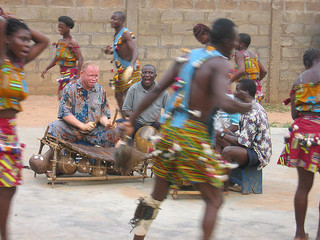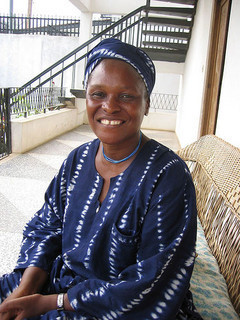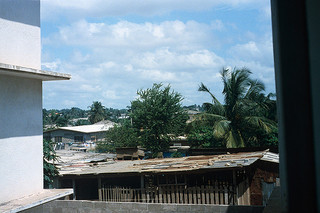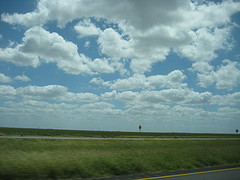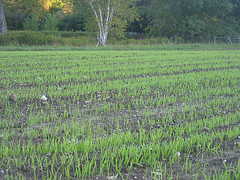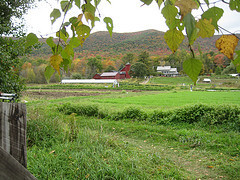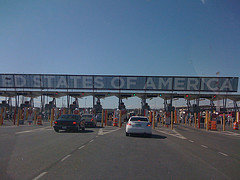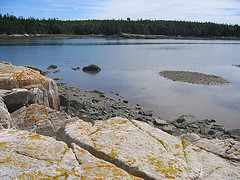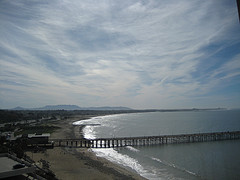Rachel Barenblat's Blog, page 218
July 11, 2012
The Torah of Local Hero
When Helene invited me to show a favorite movie in what she was calling "The Rabbis' Favorite Films" series, I spent some time pondering what I might do. Finally I came to her and said, look, there are plenty of Jewish movies I've enjoyed, but the truth of the matter is, my favorite movie isn't Jewish per se. It's called Local Hero. (IMDB entry; Wikipedia entry.)
The Local Hero theatrical trailer. If you can't see it, you can go directly to it at YouTube.
To my surprise, her face lit up. She told me that she and her husband had been to Pennan, the small town in Scotland where most of Local Hero was filmed. It happens that so have I; Ethan and I went there on our honeymoon. We traded stories of Pennan and what it had meant to us.
That's it, she said; you have to show that film. What are the odds of two families in our tiny congregation having been to this remote bit of Scotland for the same reason, and having been so moved?
I never imagined, when I was a kid, that I would settle in a small town in New England. I'm a Texan born and bred. Maybe that's part of why this movie grabbed my heart and wouldn't let go. "Mac" MacIntyre is a quintessential Texan -- he works for an oil company, even -- but once he comes to Ferness, he makes connections he would never have imagined. That small northern town changes him.
My husband Ethan, who showed me Local Hero when we were first dating, says now that we don't choose favorite movies -- often, favorite movies choose us. So why did this movie choose me? And can I make it relevant to the themes you usually hear me talking about here at synagogue?
I could try to argue that Mac is secretly Jewish -- we learn early on that he's not Scottish; his father chose the surname MacIntyre upon immigration from Hungary because it "sounded American" -- but there's no textual evidence for that. Instead, I want to argue that there's Jewish value in this film not because it has any Jewish characters, but because it relates to Jewish themes.
For me, part of what makes Local Hero a good movie, and a movie that's worth watching many times, is that it isn't reducible to a simple message or platitude. But when I watch this film through Jewish eyes, I find three primary things which seem to me to be aligned with Torah teachings.
1) Do Not Destroy
We read in the Babylonian Talmud, Tractate Shabbat 67b:
"One who covers an oil lamp [causing the flame to burn inefficiently] or uncovers a kerosene lamp [allowing the fuel to evaporate faster] violates the prohibition of bal tashchit / Do not destroy."
Preservation of earth's natural resources is surely a theme in this film. Actually, questions of burning oil are directly relevant, since the whole plot is sparked by Mac's journey to purchase Ferness and turn the town into an oil refinery. Although Danny's boyish enthusiasm and Marina's dreams of a marine laboratory initially seem far-fetched, in the end they turn out to be more meaningful and more important than anyone realized -- certainly not our protagonist Mac.
In Sefer Ha-Hinukh, the Book of Education (Rabbi Pinhas haLevi of Barcelona, 16th century), we read:
"The root reason for the precept [of Bal Tashchit/do not destroy] is known: for it is in order to train our spirits to love what is good and beneficial and to cling to goodness..." It is good to be "distressed at every ruination and spoilage that they see; and if they are able to do any rescuing, they will save anything from destruction, with all their power."
Old Ben in his shack, saving the wonders which wash up on the beach, knows this teaching deep in his bones.
2) Friendship matters
Life without amiable companionship was unthinkable to the sages of the Talmud. According to one rabbinic story, when the legendary miracle-worker Honi the Circle-Maker woke from seventy years of sleep, he faced despair because he was shunned by a new generation of scholars who neither recognized nor attended to him. In his suffering, Honi prayed for death to release him from loneliness, prompting an unnamed sage to utter, "Either friendship or death" (Babylonian Talmud Ta'anit 23a).
The benefits of friendship are appreciated by Jewish tradition. Ecclesiastes wrote, "Two are better than one because they have a good reward for their labor. For if they fall, the one will lift up his fellow; but woe to him that is alone when he falls, for he has not another to help him up" (4:9-10).
Friendship is clearly more than a social connection in the Jewish context. Friends offer each other help, loyalty, protection, support, unselfish love, and moral guidance. Judaism defines friendship as one of the primary relationships in life, a tie at times exceeding that which bonds blood relatives.
(Source: My Jewish Learning)
Mac begins the film essentially alone. He knows people, but are any of them truly his friends?
Rabbi Moshe Leib [of Sassov, a late 18th-century Ukrainian Hasidic master] told this story:
"A peasant was sitting in an inn with other peasants, drinking. For a long time he was as silent as all the rest, but when he was moved by wine, he asked one of the men seated beside him, 'Tell me, do you love me or don't you love me?'
"The other peasant replied, 'I love you very much’.
"But the first peasant replied, 'You say that you love me, but you do not know what I need. If you really loved me, you would know.'
"The other had not a word to say to this, and the peasant who had put the question fell silent again.
"But I understood. To know the needs of men and to bear the burden of their sorrow--that is the true love of men."
That's from Martin Buber (1878-1965), a prolific author and influential Jewish thinker -- found in Tales of the Hasidim, vol. 2: The Later Masters (Schocken Books).
Mac's transformation over the course of the film has much to do with finding friends. His relationship with Gordon (and I would argue also with Stella, though we don't often see them together on screen) offers him a new vision of how to be in the world and diminishes his loneliness. His encounter with the community in Ferness -- their close-knit togetherness, the ceilidh, even the cluster of men jointly looking after the baby -- gives him a new way of seeing his place in the world.
And that brings me to the third thing I wanted to mention:
3) Travel changes you.
Ultimately, the deepest message I find in this movie is that going places changes us.
When Mac left on his trip, he thought it would be brief; he didn't even consider the possibility of finding meaning in it. (He asked whether he could just do the deal by Telex!)
But once he gets to Ferness, the fact of being away from home -- on a journey with an unknown destination -- changes him. He opens up to people and ideas he wouldn't have considered before: not just Victor the friendly Russian, but the whole Ferness way of life. His wardrobe changes are an exterior reflection of his interior transformation: watch as he moves from suit and tie, to blazer and sweater, to rolled-up shirtsleeves.
And then back to suit and tie again at the movie's end. When the film ends, he is home again, but something in him has changed. Much like how we move through the spiritual journey of a Jewish year, and each year return to the same calendar date where we began -- but hopefully we've opened ourselves to new adventures along the way.
Our tradition often speaks in terms of aliyah, "ascent," up to Jerusalem or to the Land of Israel writ large. But I would argue that in some ways, the journey itself is often the destination. The peregrinations, the comings and goings, the patriarchs and matriarchs entering the land and leaving it again.
I would argue that anywhere can be a place of pilgrimage if we open ourselves to change. And Mac does open himself, and I think that by the film's end he is different than the man he was when the movie began. The final image is poignant for me: is he calling Ferness? Will anyone answer? Having left his magical place of transformation, what in him is different?
Forsyth doesn't show us the answer to that question. Maybe it's best if we decide it for ourselves.
July 10, 2012
New stories, new leadership, new hope
WASHINGTON -- When Waleed Issa walked into the Americans for Peace Now (APN) Washington, DC office on the first day of his summer internship in June, the 25-year-old Palestinian from the Dheisheh refugee camp south of Bethlehem was startled by what he saw.
"I never saw so much blue and white in my life," he says. "Everywhere you look, there's a Star of David and the colors of the Israeli flag. As a Palestinian, I thought to myself, 'This is not good news. How am I going to work here for the next six weeks?'"
That's the beginning of the article Jewish, Palestinian American groups 'swap' summer interns, originally published in The Times of Israel. Palestinian Waleed Issa has been interning with Americans for Peace Now, and Israeli Or Amir has been interning with The American Task Force on Palestine. Waleed grew up in Dehesha refugee camp in Bethlehem; Or is a former officer in the IDF's medical corps, formerly stationed outside of Gaza. Both are in the States this summer as part of a unique program:
Or and Waleed are among 10 young people - five Israelis and five Palestinians - brought to Washington this summer by a group called New Story Leadership which, according to its website, "introduces a radically different approach to peace-building, one that does not pretend to solve the historical controversies or mediate between antagonists."
Instead, the group offers what it calls a "narrative-based program" that wants participants to focus on creating new stories based on mutual interest and cooperation, rather than "stories that endlessly recycle old grievances, inflate differences and inflame passions."
The whole article is worth reading. Every time I hear about a program like this one, another tendril of hope takes root in my heart.
Dancing With the Widow (reprint of an essay from 2000)
Like the others, she's clad in skirt and blouse with an extra yard of fabric wrapped shawl-fashion. Unlike the others, she wears a coarse rope around her waist. Sometimes another woman leads her by it, into the dancing, out of the dancing. Sometimes it just dangles. We are in the town of Medie. The bound woman is a new widow: the dancing is her husband’s wake.
Medie is a village not far north of Accra, Ghana's capital city. Medie is not a place many Westerners visit, although that may change in time. We are there because the elder brother of a close friend has died of lung cancer ("He wasn't Y2K-compliant," jokes our friend, familiar with the Y2K bug although he's never used a computer) and we are there for the last six hours of his two-day wake.
Xylophone music in Medie. A few years after this funeral.
Under a large shady tree, several dozen men in embroidered bata kari (the smocks traditional to Northern Ghana) cluster together singing. Three men play balafon, the Dagadi xylophone with wooden keys and buzzing gourds. One man plays sticks; one man drums. The combination of rhythms is so complicated it sounds like chaos to my untrained ear.
Every now and then a throng of women exits the shade of the women’s tent and dances, shuffling steps and rhythmic pauses, bent forward, arms out like birds' wings. It is a dance everyone seems to know. A few of the women wail, including the roped widow.
An old woman pulls my arm and brings me into the dance. The children laugh: I am a spectacle, the white woman who doesn't know what she's doing. "Follow me," she says, and starts moving. "Follow me."
Our friend Fortune is with us, acting as cultural interpreter. "Funeral traditions vary depending on the tribe," she explains. "In some peoples, the widow must go barefoot from when the husband dies until the end of his funeral and wake-keeping. Some widows must wear black. Some must wear rope."
Fortune is a smallish woman with hair pulled back and laugh lines around her eyes. She befriended my husband when he lived in Ghana, six years ago. Once she was a trader, buying and selling beads and cloth in Nigeria, Togo and Ghana. These days Nigeria is unfriendly, Togo is questionable, and she doesn't have the necessary capital to trade anyway. She knows everyone, and speaks at least four languages (English, the national tongue; Ewe, the language of her people; and the additional tribal languages of Ga and Twi). Fortune is divorced, a rarity in Ghana.
"There are remarriage rules for widows," Fortune tells us. "Often, if the woman has children, she must marry a man from the husband's family, so that the children stay in the family." There is a pause. "Of course, if a woman dies the husband is free." She doesn't roll her eyes at this, not exactly, but her expression and tone have the same effect. 'Go figure,' she seems to be saying. 'When a man dies his wife gains restrictions; when a woman dies, her husband can do anything he wants. Where is the fairness in that?'
Osu. Photo taken in 1993.
The wake ends around six. As the tents are dismantled, dark clouds gather: we are sure it's going to pour, but the rain never comes. We return to Accra, to a neighborhood called Osu, where Fortune and her husband Patrick used to live. They're down on their luck at the moment: she's living with her mother, he's sleeping on a cot in an Osu furniture storage shed.
We arrive to find their living room set outside the storage shed, on the dirt floor of the compound. We sit on their sofas, under the starry sky, and talk about politics: the upcoming Ghanaian election, Hillary Clinton's run for the NY senate seat. Fortune disappears into the shed. When she emerges she bears a feast: omo tuo, twice-cooked rice balls, with a spicy groundnut stew. It is among the best meals I've eaten anywhere. Prepared on a single charcoal brazier, behind closed doors.
The day—the longest one of our trip—ends with our dinner at Fortune's. By the time we reach our room it has been night for hours. We have cleansed our palates with fresh pineapple; once we climb the stairs to our room we are almost too tired to brush our teeth.
When I close my eyes Africa swims around me. The sounds and smells and images, everything my brain has stored up from the day, closes over me like the ocean.
When I close my eyes the old woman beckons again. "Follow me," she says. She is leading me into the funeral, into every sprawling market, into the homes of our friends, into the world I want to understand. "Follow me."
I am still following.
This essay was published in the now-defunct The Women's Times in February, 2000. Reading Ethan's recent post Ghanaian Ambitions made me want to dig this up; it's amazing to hear about how Accra has changed. I hope to return there someday.
All images courtesy of Ethan's flickr stream.
July 9, 2012
Rebuilding with our Torah and our hearts
"One who doesn't build the Beit HaMikdash in their own time, it's as though they had destroyed it." (Talmud Yerushalmi, Yoma 1:1.)
Even those who are pillars of the world go to their rest without building the Beit HaMikdash in their days. But in truth, the righteous in every era do build in their days a part of the Beit HaMikdash! Each one adds the spark which comes from his/her own heart.
The idea that "anyone who doesn't build the Beit HaMikdash in their days, it's as though they had destroyed it" -- that means someone who doesn't understand which aspect of Torah learning is truly their own. That's the part of the Beit HaMikdash that person is supposed to be building, and if one doesn't know, then one doesn't build.
So one must pray for redemption, and to strengthen one's knowledge, and one's awe, and to understand what one doesn't yet know. That's what it means to "go up to the place which God has chosen." (Deut. 17:8.)
That's the Hasidic master known as the Bnei Yissachar (R. Zvi Elimelech Spira of Dinov, who died in 1841.) He's commenting on a line from the Jerusalem Talmud which says that one who doesn't rebuild the Beit HaMikdash -- the Temple in Jerusalem -- in his own time is as guilty of its destruction as those who tore the Temple down.
That's a tough idea for those of us who have ambivalent feelings about the whole notion of the Temple. Most liberal Jews today decidedly do not wish to restore Temple sacrifice. (Neither Reform nor Reconstructionist Judaism nurtures this hope.) We tend to see the the destruction of the Temple as the brokenness out of which the new paradigm of rabbinic Judaism could emerge, and we don't want to return to the old paradigm. There's also the matter of contemporary geopolitics; two Muslim holy sites now occupy the top of that mountain.
The Bnei Yissaschar, though, offers a reading which I find really beautiful. The righteous in every era do rebuild the house of holiness, he says; each of us lifts up the spark in our own soul and our own heart, and together we collaborate on healing the cosmic rupture. Someone who doesn't rebuild, and who is therefore considered (by the sages) to be as guilty as the actual destroyers -- that means someone who doesn't take the time to learn which aspect of Torah is truly their own, which spark they're meant to uplift.
I love the idea that each of us can contribute a spark to the building of the Beit HaMikdash. The Bnei Yissachar is not talking about actually rebuilding a structure out of stones and mortar. Rather, he's talking about co-creating a spiritual structure of transformation through putting our hearts and souls together. And I love the idea that we do this, each of us, by learning the Torah which is truly ours to learn and to teach, and then lifting up the sparks of that learning and teaching to God.
How do I know which Torah is mine? Which Torah I most need to learn and to teach in order to contribute my irreplaceable spark to this collective enterprise? I don't have an easy answer to that. Sometimes I think that "my" Torah is the Torah which most powerfully calls to me and which makes me yearn to share it with others. Other times I think that "my" Torah is whatever Torah I most need to wrestle with: the tough texts, the painful passages, what I need to redeem in my own ways. Often I suspect I won't know which Torah was most truly mine until my life nears its end -- if then.
During these Three Weeks when Jews around the world are mourning the long-ago siege of Jerusalem and the fall of the Temple, the shattering of the place where we once felt we had a "direct line" to God, at least I can continue to learn Torah. And maybe I'll happen upon the teaching I most need to learn, and most need to teach, in order to do my part in the rebuilding which has nothing to do with the physical world of real estate and everything to do with the heights of holiness in the human heart.
With thanks to R' Eliot Ginsburg.
July 7, 2012
The Three Weeks: healing our sight
According to Sefer Yetzirah, to each month of the Jewish calendar there corresponds a letter of the Hebrew alphabet, a zodiac sign, one of the twelve tribes of Israel, a sense, and a controlling limb of the body...
That's from The Month of Tamuz According to the Book of Formation (Sefer Yetzirah) at Inner.org, a website which collects the kabbalistic teachings of Rabbi Yitzchak Ginsburgh. R' Ginsburgh teaches that the sense associated with this month is sight. And the tribe associated with this month is Reuben -- a name which comes from the same root as the verb "to see."
Our task this month, he teaches, is to rectify, or heal, our own sight. "[O]ne must train one's eyes (both spiritual and physical) to see only the inner positive dimension of reality and not to focus upon reality's outer, negative 'shell.'" On another page at that same site -- The Month of Tamuz: The End of Tragedy -- we read:
The sense of the month of Tamuz is sight. This means that the month of Tamuz is the best month of the year to learn to exercise our sight in the most positive way possible. Rectified sight involves both shying away from that which is negative (an ability associated in Kabbalah with our left eye) and training ourselves to see things in a positive light (associated with our right eye). In essence, both aspects are included in the right eye, which means that we should seek to see only the good points in others.
I love this idea: that this month it is our task to learn to stop seeing the bad in people, and to perfect the art of seeing the good in people. I make a year-long practice of trying to see the good in people, but there's something especially meaningful to me about the idea of strengthening that practice during this time.
We've entered the Three Weeks when we are bein ha-meitzarim, caught in the narrow straits of remembered grief and suffering. We remember the sack of Jerusalem and the fall of the Beit haMikdash, the house of holiness where we once understood God's presence to dwell. I keep returning to the text from Talmud which teaches that it was sinat chinam, needless hatred between and among our community, which brought the Temple down. And I find that I'm feeling even more keenly than usual the wish that I could create bridges of understanding between people who don't see eye to eye.
If we could all spend these Three Weeks healing our sight so that we truly only see the good in one another, how might the world be different? I'm not talking about superficial pretense, but about really training ourselves to see the best in people. Imagine seeing the best not only in your friends, but in the guy who cuts you off in traffic; in someone who looks different from you; in someone whose political positions are the opposite of yours.
Imagine Democrats and Republicans not just pretending to like one another, or focusing on their common ground in order to get along, but really figuring out how to see the good in each other. Imagine AIPAC supporters and Jewish Voice for Peace supporters doing the same. Secular Israelis and ultra-Orthodox Israelis. Soldiers and refuseniks. Israelis and Palestinians.
The classical tradition, I suspect, would argue that our task is to learn to see the best in each other within our community, not outside the bounds of our community. (Define those boundaries how you will.) But my teacher Reb Zalman Schachter-Shalomi has taught that in this age of paradigm shift, we need to move beyond triumphalism to an organismic understanding of our place in the world. Each religion is a necessary organ in the body of humanity; we need to maintain our differences, but we also need to communicate and connect. Maybe the best way to do that is to learn to see the best in one another.
May our vision be healed; may we learn how to look at each other and to see not our flaws and failings and differences but our holy sparks, our souls which shine, no matter who we are.
I'm collecting used eyeglasses at my synagogue during the Three Weeks, with the intent of donating them to OneSight after Tisha b'Av. If you live locally and might have eyeglasses to donate, you can learn more at my From the Rabbi blog.
July 6, 2012
17 Tammuz: the walls begin to fall
One of the five minor fast days on the Jewish calendar is coming up this weekend: 17 Tammuz, the day when we mourn the breaching of the walls of Jerusalem before the destruction of the Second Temple in 70 C.E. On 17 Tammuz we also remember the breaking of the first set of tablets of the Ten Commandments when Moshe came down the mountain and saw the children of Israel worshipping the golden calf. (A side note: this year 17 Tammuz falls on a Shabbat, so the fast will be observed on Sunday, the 18th of Tammuz, instead.) 17 Tammuz is the beginning of the "Three Weeks," also known as bein ha-meitzarim -- "between the narrows" or "in tight straits" -- a period of semi-mourning which culminates with Tisha b'Av.
I didn't grow up observing 17 Tammuz or the Three Weeks (or, for that matter, Tisha b'Av.) The Three Weeks aren't universally observed in the liberal Jewish world. (See Do Reform Jews Observe the Three Weeks?) Some of us are unaware of this fast day, and others may feel some resistance to commemorating it by eschewing food all through the daylight hours of the day. What does it mean to mourn the siege of a city almost two thousand years ago, the breaching of the first wall which led to the fall of the Temple, especially when many of us no longer see the Temple Mount as the axis mundi, the umbilicus of creation, the place where communication with God is uniquely possible?
Rabbi Lynn Gottlieb suggests that 17 Tammuz is a day to mourn the ways in which the structures of peace are being dismantled in our time. Hearing that, some of us may think of olive trees uprooted and homes demolished; others may think of the removal of settlers from Gaza. What are the impediments to peace in today's Jerusalem? There's passionate disagreement on that front -- which makes me also think: what are the impediments to peace between and among us, in our community, who see the situation in Israel and Palestine in differing ways? The Talmud (tractate Yoma) tells us the Second Temple fell because of sinat chinam, "baseless hatred," within our community. Are we any kinder than our ancestors were?
How are the structures of caring and compassion dismantled in our time? The structures of understanding, gentleness, kindness?
Whether or not you are fasting on 17 Tammuz, consider donating what you would ordinarily spend on a day's food budget to an organization which works to effect healing. Combatants for Peace works to create healing and change in the Middle East; RAINN (the Rape, Abuse, and Incest National Network) works to create healing for those who have suffered rape or abuse. Or choose a group in your community which works to alleviate some of the brokenness of our world.
What can we learn from the teaching that Moshe shattered the first set of tablets, broken-hearted at the apostasy of the community he served, on this same day when we remember the breaking of Jerusalem's city walls? Maybe that hope lies in learning how to care for that which is broken. Midrash holds that the children of Israel carried the broken tablets along with the second set of whole ones in the ark of the covenant. That which is broken is still holy, is still deserving of our respect and our care. "There is nothing so whole," said Reb Menachem Mendel of Kotzk, "as the broken heart."
On 17 Tammuz; on every day of the year; may we learn to extend hope and kindness to all who suffer. May we learn that in our very brokenness lies the possibility of healing and transformation.
July 5, 2012
Reflections on a first year
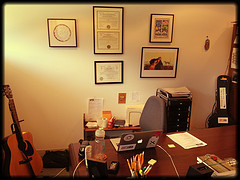 One evening, about a year ago, I brought my son to the synagogue in the evening and fed him supper while meeting with the president of the board. When he started to melt down, I signed the contract which had been sitting on the table between us, and took him home to prepare for bedtime. The next day, while he was playing with his grandparents, I loaded up my car with boxes of Judaic books and brought them to work -- where I wound up beginning to prepare for a funeral, a bat mitzvah, and the Days of Awe. (So much for "I'm just going to bring over some boxes of books, I won't be long...")
One evening, about a year ago, I brought my son to the synagogue in the evening and fed him supper while meeting with the president of the board. When he started to melt down, I signed the contract which had been sitting on the table between us, and took him home to prepare for bedtime. The next day, while he was playing with his grandparents, I loaded up my car with boxes of Judaic books and brought them to work -- where I wound up beginning to prepare for a funeral, a bat mitzvah, and the Days of Awe. (So much for "I'm just going to bring over some boxes of books, I won't be long...")
Last night, at the tail-end of the congregational Fourth of July party, as "We Are Family" poured forth from a congregant's ipod and my son ate his millionth slice of watermelon, I signed a contract again. When I had signed all three copies, and so had the board president, she grinned at me and we shook hands with mock-solemnity.
I want to write something about this first year of my active rabbinate -- this first year of serving my community as its rabbi -- but I find I'm not sure where to begin. Is it even possible to begin to encapsulate this first year? The kaleidscope of images in my mind's eye is too full and varied. Preparing for Shabbat after Shabbat. Preparing for the Days of Awe. Celebrations of bar and bat mitzvah, watching our kids shine. Funerals of congregants I had known, and funerals of people who had been unknown to me until their deaths brought them front-and-center into my consciousness.
Speaking with a congregant one-on-one about something unfolding in their life. Sitting by the bedside of a man who was beginning his passage out of this life, singing him the niggun which asks the question of why a soul incarnates in this world. Standing in front of the open ark at the final service of last Yom Kippur, singing Avinu Malkeinu with all my heart and all my hoarse voice. Meditating in our sanctuary immersed in the silence of a thick winter snowfall -- and surrounded by the waterfall of summer birdsong. My son, at the cookout yesterday, gleefully banging the cymbals he had found in our basket of sanctuary instruments.
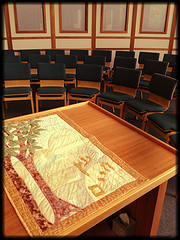 Times when I tried something and it worked -- and times when I came away feeling that I hadn't lived up to what I wanted to be. Times when I felt I was really reaching people, and times when I felt as though I had borrowed Sisyphus' rock and it was about to roll back down the hill. The quiet glow of satisfaction when someone who had seemed just the tiniest bit dubious about me began to call me "Rabbi," and the chagrin when a lesson I had thought would move our b'nei mitzvah students devolved instead into a flurry of paper airplanes and inappropriate remarks. The gladness when I was able to give over a teaching I'd received from my teachers, a melody I had learned from a friend, and to feel that it had hit home.
Times when I tried something and it worked -- and times when I came away feeling that I hadn't lived up to what I wanted to be. Times when I felt I was really reaching people, and times when I felt as though I had borrowed Sisyphus' rock and it was about to roll back down the hill. The quiet glow of satisfaction when someone who had seemed just the tiniest bit dubious about me began to call me "Rabbi," and the chagrin when a lesson I had thought would move our b'nei mitzvah students devolved instead into a flurry of paper airplanes and inappropriate remarks. The gladness when I was able to give over a teaching I'd received from my teachers, a melody I had learned from a friend, and to feel that it had hit home.
When I began telling people, a year and change ago, that I was working with this community to develop a job description for a "halftime pulpit," many of my friends and colleagues laughed. There's no such thing as a halftime rabbi, people said; only a halftime salary! And they weren't wrong. I'm a rabbi all the time, just as I'm a poet all the time, just as I'm a mother all the time. The rabbinate is a vocation, not merely X hours of work for Y dollars in pay. And a rabbi's work is never done. I could always be doing more: more pastoral care visits, more trips to the hospital, more phone calls to check in, more b'nei mitzvah tutoring, more preparation for services, more learning, more Torah study, more teaching.
And yet. In this first year I have found that the halftime model is a blessing. Not only for practical and financial reasons, but also because it gives me a different way of thinking about life and work and how they intersect. A rabbi's work is never done -- but it would be all too easy to keep trying to finish it even so. All of us who enter this line of work do so because we want to serve. How easy it would be to say to myself, "if I just put in another hour today..." If I just stayed a bit later tonight -- if I picked up the laptop again after the toddler goes to bed -- if I worked both days this weekend instead of only one...
But the work is neverending, and I know that. And that's the blessing, assuming I can let go of the fantasy of ever being "done." All I can do is what I can do today during the hours I've allotted. After that, I have to leave work and pick up my son and take him to a playground, or make him dinner, or read him books. This turns out to be an incredible gift. I am blessed to serve as a rabbi. And I am also blessed to step away from my desk at the end of the day, having done as much as I could, and to let go of what remains un-done... which in turn allows me to return, ready to pick up the yoke again. "It's not incumbent upon us to finish the task" -- that's as much a statement about life as it is about my job. That's the way life is meant to be.
Of course there are times when this truth is hard to remember. Like any working parent, I have days when I fear that I'm shortchanging either my family or my job (or both.) But my tradition teaches me that in every moment, God speaks the world into being, and in every moment teshuvah -- re/turning, re-orienting, starting-over -- is possible. Even when a lesson plan has failed, or I've communicated something poorly, or the to-do list looms, I can take a deep breath, find the blessing in whatever is arising, and begin again. As, now, I take a deep breath, thank God and my community alike for the gift of this first year of serving Congregation Beth Israel, and begin to write the book of year two.
July 4, 2012
America
O beautiful for spacious skies (highway, south Texas)
for amber waves of grain (winter rye, western Massachusetts)
For purple mountains' majesty (Berkshires, western Massachusetts)
Above the fruited plain (strawberry field, western Massachusetts)
America, America, God shed His grace on thee (border crossing, northern New York)
And crown thy good with brotherhood, from sea (rocky coast, Maine: Atlantic)
to shining sea (jetty, southern California: Pacific)!
(lyrics from America the Beautiful.) Happy Fourth of July to all who celebrate!
July 3, 2012
70 faces featured on How to Blog a Book
My book 70 faces and I have the honor of being featured on Nina Amir's How to Blog a Book today. Nina started that blog as a place to talk about "how to blog a book" -- how to use a blog for the purpose of writing a nonfiction book -- though once the blog was underway, she found herself also posting about blogging and books more generally, as well as "how to book a blog" (how to repurpose existing blog posts into a manuscript.) Anyway, she asked me some fun questions, and I had a good time answering. Here's a taste:
I begin the month with an interview with a blogger I’ve followed for quite some time in the world of Jewish spirituality. Rachel Barenblat is a rabbi and a poet as well a blogger, and in 2008, TIME magazine named her blog one of the top 25 sites on the Internet. Pretty awesome, right? At that time, I said, “I want to figure out what she is doing right.” She was writing poetry and recording it—poetry based on the weekly Torah (or Old Testament) portion read in synagogue each week. And at that time she wasn’t even a rabbi yet!
Anyway, she already had a few chapbooks out, but now she has more published books. So, here’s her blog-to-book story, chock full of great advice on how to blog well, blog a book, book a blog and generally succeed as a blogger and an author or poet...
What advice would you offer to aspiring writers who might want to turn their blogs into books or blog a book?
Set yourself a goal and stick to it. One hundred words a day? One page a day? One post a week? Whatever it is, pick it and stick with it for at least a month—long enough for the habit to begin to become engrained. And cultivate friends (readers, other bloggers who are also writers) who are interested in commenting on your work! A good reader is worth their weight in gold. (For what it’s worth, I’ve found that the best way to interest other writers in my work is to be interested in theirs, and the best way to get other bloggers to read me and comment is for me to read them and respond to what they’re doing. So there’s an investment of time. But hopefully the ensuing relationship is its own reward.)
Read the whole thing here: Rachel Barenblat Speaks About Blogging and Booking Poetry. Thanks, Nina!
July 2, 2012
Three divrei Torah on Balak
This week we're in parashat Balak, which is a fun one. King Balak hires Balaam to curse the children of Israel; after hijinks with a talking donkey who sees angels, the prophet instead offers blessings. (For us, anyway.)
Here are tastes of the divrei Torah I've posted about this portion over the years.
2006:
With eyes unveiled, Balaam sees a new reality. Instead of seeing a military threat, a foreign people to be feared -- as Balak had seen -- Balaam looks into the hills and sees a people who travel with the Holy Blessed One in their midst. He sees with mochin d'gadlut, his "big mind" or expanded consciousness, instead of mochin d'katnut, constricted consciousness. And in that moment of seeing, all he can do is offer praise.
"How fair are thy tents, O Jacob / Thy dwellings, O Israel," he says. In this synechdoche, the patriarch symbolizes the whole. Jacob is the earthly, embodied side of the patriarch, the aspect that inhabits physical spaces. Israel is the other side of the coin, the part of the patriarch which wrestled with the angel of God and came away blessed. Where Jacob has tents, Israel has dwellings -- in Hebrew, Israel has mishkanot, like the holy dwelling-place of the indwelling Shekhinah.
Read the whole thing: On blessings and curses
2007:
Prophecy, writes the Sfat Emet (in Green's translation), "brings speech forth from potential to real." But in order for a prophet to have significance, there also needs to be an audience -- ideally, a receptive one. A prophet speaking in a vacuum isn't fulfilling his mission; that tree falling in the proverbial forest doesn't make a discernible sound until there are ears to hear. Balaam's prophecy was meaningful because it reached somebody's ears. In that sense, prophecy is inevitably a relational activity -- the prophet relates both to God and to the person or people who hear the prophetic words.
Read the whole thing: Prophetic (comedic) speech
2008:
If God gave voice
to my worn Birkenstocks
they would cry out
"what did we ever do to you..."
Read the whole thing: Sandals.
Rachel Barenblat's Blog
- Rachel Barenblat's profile
- 6 followers


